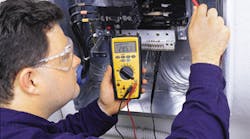Here’s a primer on symbology, terminology, connections, and basic measurement techniques for modern multimeters
Adigital multimeter (DMM) may look complicated and intimidating at first glance, but once you understand the display, dial, and port panel, you'll have a better grasp of DMM basics.
Multimeters come in two types: digital and analog. Most electricians today use digital multimeters. DMMs feature a digital or liquid crystal display (LCD), where measurement readings in exact numerical values appear. The display also alerts you to any pertinent symbols and warnings.
The dial of the DMM allows you to select the function you want to measure. Whether you intend to measure one of the three elements of Ohm's Law or a more advanced function like frequency or capacitance, you must first set the dial to the appropriate function.
The dial also plays another essential role in measuring electricity: determining the range of measurement. The range you select on the dial determines the placement of the decimal point as it appears on the LCD. In turn, the position of the decimal point determines how refined, or precise, your reading is. This is called resolution.
To get a better understanding of resolution, let's examine what range to set the dial to if you're going to test AC voltage. The highest possible reading with the range set to 20V is 19.99V. The highest reading with the range set to 200V is 199.9V. As you can see, in the transition from 20V to 200V, the decimal point has moved one place to the right, yielding a less refined resolution. So setting the dial to the lowest possible range yields the best resolution.
However, if the range is set on 20V and you're measuring an application that puts out more than 20V, the display will read OL, or overload. You must reset the dial to a higher range and take a new reading. The most refined reading, therefore, uses the range that provides the best resolution without overloading. Select the range just higher than the expected reading.
Testing voltage.
Know the Difference Between DMMs
Not all digital multimeters (DMMs) are the same. They're all calibrated to give an rms indication for the measured signal. However, the difference between them is the method of calculation. The three commonly used methods are as follows:
Peak method: The meter reads the peak of the signal and then divides the result by 1.414 (the square root of 2) to get the rms value.
Averaging method: The meter determines the average value of the rectified signal. For a clean, sinusoidal signal, this average value is related to the rms value by the constant k, which is equal to 1.1. The meter uses this value k to scale all the waveforms it measures.
True rms: The meter measures the heating that will result if the voltage is impressed across a resistive load. One method to detect the true rms value is by using a thermal detector to measure a heating value. However, modern DMMs use a digital calculation of the rms value by squaring the signal on a sample-by-sample basis, averaging over a period, and then taking the square root of the result.
All these methods give the same result for a clean, undistorted, sinusoidal signal, but they can give different answers for distorted signals, and significant distortion levels aren't uncommon.
To test for voltage, first determine whether the application you're testing uses AC or DC voltage. Then set the dial to the appropriate function: V_ for AC voltage or V for DC voltage.
Like all test procedures, when testing voltage set the range to the number just higher than the expected reading. If you don't know the expected range, set the range to the highest number.
Plug your test leads into the port panel as described in Fig. 1. For AC voltage, take the leads and apply them to the circuit, making sure that no part of your body contacts any part of the live circuit. The position of the test leads may need to be adjusted until a reliable measurement appears on the LCD. Then read the voltage measurement displayed.
When testing AC voltage, you'll encounter fluctuations in the reading. As the test continues the reading will stabilize to yield a reliable measurement.
For DC voltage, connect the black test lead to the negative polarity point (ground) and the red lead to the positive polarity test point. Then take a reading.
Testing current.
You can test current in several ways, but the most common — and simplest — method is with a clamp meter. The advantage of testing current with a clamp meter — or a standard DMM with a clamp head accessory — is that readings can be taken without opening the circuit.
To test for current first determine if you're testing AC or DC current. Then set the dial to the appropriate function: A_ for AC current or A for DC current. Next, set the appropriate range on the dial.
Testing with a clamp meter. If you're using a clamp meter, open the clamp head by pressing the lever. Close the head around a single conductor and release the lever. Make sure it has completely closed around the conductor, and take a measurement.
Testing with a standard DMM and current clamp adapter. The clamp adapter will convert the current measurement into voltage. Therefore, set the dial to the AC voltage function and select the millivolt range. Plug in the leads and open the clamp adapter. Close the clamp head around a single wire, and take your reading.
Testing with a standard DMM and test leads. To measure current on an open line using test leads, plug in the leads and set the dial to AC or DC current depending on what you're testing. Apply the leads to the open current, and take a reading.
Note that for current measurements above 1A, it's most common to use a clamp meter. For measurements less than 1A, it's preferable to use a standard DMM.
Testing resistance.
To test for resistance, first turn off the power in the circuit or component you're testing. Otherwise you may not get the most accurate reading and damage the DMM. After ensuring that all power is off, set the dial to the resistance mode. Select the appropriate range on the dial. Plug in your test leads, connect them to the component under test, and take a reading.
It's important that you have good contact between the test leads and circuit you're testing. Dirt, oil, bodily contact, and poor test lead connection can significantly increase resistance readings.
The most common resistance test is performed on a standard outlet where ground resistance should be 1 ohm or less.
Testing continuity.
It's essential that circuits are continuous or complete, thereby allowing current to flow. Switches, fuses, conductors, and wire connectors demand good continuity. While good fuses and closed switches have good continuity, blown fuses and open switches have no continuity. A common continuity test verifies that the test leads are good before using the DMM.
The continuity test on a DMM is simple. Set the dial to the continuity function. Plug in your lead. After ensuring that the power is off, make contact with the component under test using the leads. The DMM will beep if there is good continuity, or a good path that allows current to flow. If there is no continuity, the DMM won't beep.
Testing capacitance.
To test capacitance, set the dial on the DMM to the capacitance function and plug in your leads. After ensuring that the capacitor has been discharged, connect the test leads to the capacitor terminals and take a reading. If the measurement is similar to the rating listed on the capacitor, the capacitor is good. A significant variation from the rating indicates the capacitor should be replaced.
Testing frequency.
Frequency is measured in hertz (Hz) — the number of times per second a waveform repeats. Maintaining the right frequency is crucial for devices that rely on AC voltage and current. However, it's important to realize that not all DMMs include a Hz testing function.
To test frequency, set the function switch to Hz. Plug in your leads and connect them to the circuit. Read the measurement and compare it with the frequency listed for the component under test.
Advanced DMM features.
When taking AC measurements in commercial and industrial environments, an electrician needs a DMM with a true-rms feature. DMMs take AC measurements using either an averaging method or a true rms method. Average responding DMMs take an AC measurement, multiply it by 1.11, and then display it on the LCD. This method is accurate when a pure sine wave exists like in residential environments. But electronic lighting ballasts, variable speed motor drives, computers, and other electronic equipment in commercial and industrial environments cause harmonics that distort the sine wave. In these cases a DMM needs a true rms feature, which measures the waveform using a root mean square (rms) calculation to provide an accurate reading.
When taking a measurement using a DMM, it's sometimes useful to capture and retain the reading as it appears on the display. If you're taking a measurement in a dimly lit or tight area, the data hold button retains the measurement on the LCD until it can be easily read. You can capture the reading simply by pushing the button.
Pushing the max hold button will allow you to capture the highest reading of any given measurement. If the reading falls to a lower value, this button ensures the highest value remains on the screen. It's especially helpful in capturing the in-rush current flow when equipment is first turned on.
An auto ranging DMM doesn't require you to set the range on the dial. Select the function you're measuring and the auto ranging DMM automatically establishes the range that yields the best resolution.
With all of its buttons, features, and options, a digital multimeter can be an intimidating instrument, but it doesn't have to be. The Table above should help with some of the symbols and abbreviations. Attempting to maintain an electrical system without a DMM is a daunting task. If you take the time to learn how to use one correctly, you'll drastically expand your testing capabilities and eliminate some of the guesswork.
Gregorec is Group Manager, Test and Measurement, Ideal Industries, Sycamore, Ill.



